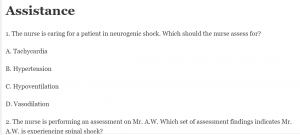Assistance

1. The nurse is caring for a patient in neurogenic shock. Which should the nurse assess for?
A. Tachycardia
B. Hypertension
C. Hypoventilation
D. Vasodilation
2. The nurse is performing an assessment on Mr. A.W. Which set of assessment findings indicates Mr. A.W. is experiencing spinal shock?
a. Decreased reflexes and flaccid paralysis
b. Hypotension and bradycardia
c. Dyspnea and constricted airway
d. Tachycardia and confusion
3. After 5 days in the intensive care unit (ICU), Mr. A.W. becomes agitated, very disoriented, and reports “hearing voices.” Which interventions should the nurse perform? Select all that apply.
a. Use clocks and calendars to orient the client to time.
b. Dim lights at night and open window blinds during the day.
c. Schedule activities frequently throughout the day and night.
d. Have the family bring familiar objects from home.
e. Minimize noise from shift change and monitoring equipment.
Glasgow Coma scale
4. The nurse is assessing Ms. T.G. The nurse notes Ms. T.G. opens her eyes when the nurse calls her name but only moans when questioned. When the nurse applies pressure to the nail bed of the finger, Ms. T.G. slowly pulls her hand away from the nurse. Which rating on the Glasgow Coma Scale should the nurse document?
Glasgow Coma Scale – The Definitive Guide | Biology Dictionary
A. Glasgow Coma Scale rating of 14
B. 2. Glasgow Coma Scale rating of 12
C. 3. Glasgow Coma Scale rating of 9
D. 4. Glasgow Coma Scale rating of 7
5 A nurse is assessing a 21-year-old client diagnosed with bacterial meningitis. Which of the following signs and symptoms of meningeal irritation is the nurse likely to observe?
SELECT ALL THAT APPLY.
A. Generalized seizures
B. Nuchal rigidity
C. Positive Brudzinski’s sign
D. Positive Kernig’s sign
E. Babinski’s reflex
F. Photophobia
6.A nurse is assessing a client’s extraocular eye movement as part of the neurologic examination. Which of the following cranial nerves is the nurse assessing?
A. Optic (ll)
B. Oculomotor (lll)
C. Trochlear (lV)
D. Trigeminal (V)
E. Abducens (Vl)
F. Acoustic (Vlll)
G.
7. A nurse is assessing the level of consciousness of a client who suffered a head injury. Using the Glasgow Coma Scale, she determined that the client’s score is 15. Which of the following responses did the nurse assess in this client?
SELECT ALL THAT APPLY.
A. Spontaneous eye opening
B. Tachypnea, bradycardia, and hypotension
C. Unequal pupil size
D. Orientation to person, place, and time
E. Pain localized
F. Incomprehensible sounds
8. A nurse is caring for a client with a T5 complete spinal cord injury. Upon assessment, the nurse notes flushed skin, diaphoresis above T5, and blood pressure of 162/96 mm Hg. Which of the following nursing interventions would be appropriate for this client?
A. Elevate the head of the bed to 90 degrees
B. Loosen constrictive clothing
C. Use a fan to reduce diaphoresis
D. Assess for bladder distention and bowel impaction
E. Administer antihypertensive medication
F. Place the client in a supine position
G.
9. A nurse is monitoring a client’s intracranial pressure (ICP) after a traumatic head injury. Based on the documentation below, how should the nurse interpret this client’s ICP reading
0800
0805
0810
0815
ICP
20
18
18
16
A. ICP is elevated
B. ICP is decreased
C. ICP is within normal limit
D. ICP was elevated but returned to normal
10. A client is experiencing problems with balance as well as fine and gross motor function. Which area of the brain is malfunctioning? Place an X
Diagram Description automatically generated
11. A nurse is performing a neurological assessment on a client during a routine physical examination. To assess Babinski’s reflex, indicate the point where the nurse would place the tongue bad to begin stroking the foot
Foot isolated on white background – 94160002
12. A patient has a lesion that affects lower motor neurons. During the assessment of the patient’s lower extremities, the nurse expects to find
a.
spasticity.
b.
flaccidity.
c.
hyperactive reflexes.
d.
loss of sensation.